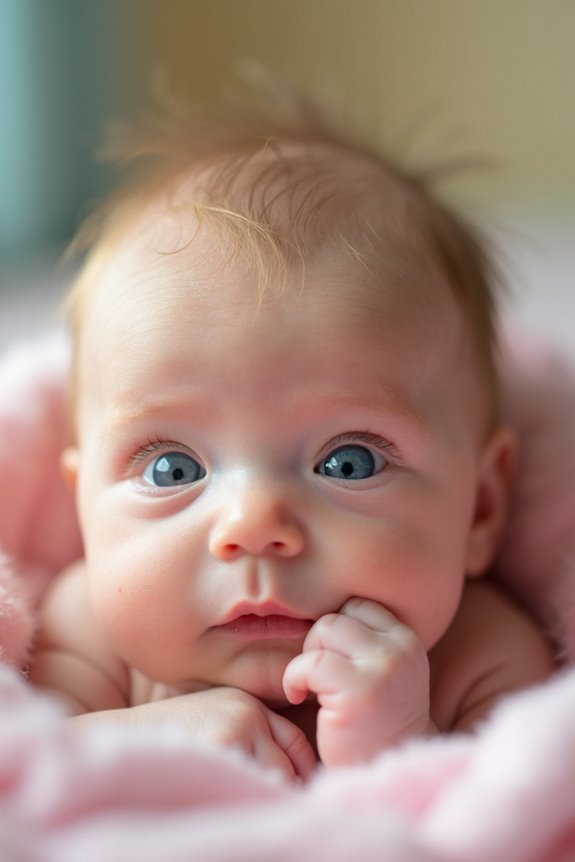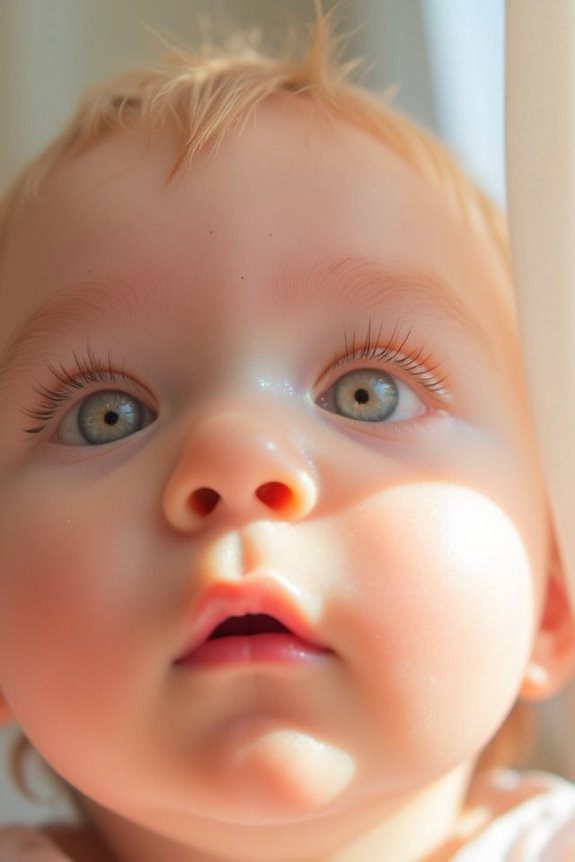When we think about what our baby might look like, several genetic factors come into play. Eye color can vary due to over 50 genes, while hair color and texture are influenced by several gene combinations too. We’ll also see the impact of skin tone from melanin production and height, which genetics accounts for around 80%. By examining family traits, we can gain clues about our little one’s appearance. Let’s explore more of these fascinating factors together!
Key Takeaways
- Your baby’s appearance is influenced by the genetic traits inherited from both parents, including complexion, height, and facial features.
- Eye color prediction involves multiple genes, with brown being dominant over green and blue, leading to various possible outcomes.
- Hair color and texture are determined by several genes, which means siblings may have noticeable differences despite shared genetics.
- Skin tone can vary significantly and is affected by melanin production, often reflecting ancestral backgrounds and environmental factors.
- Height is largely determined by genetics, with over 700 gene variants influencing growth, though nutrition also plays a role in development.
Genetic Factors Influencing Appearance
When we think about what our baby might look like, it’s fascinating to realize that a lot of their appearance is shaped by genetic factors. Gene inheritance plays a significant role in how traits express themselves in our little ones. Here are some key points to consider:
- Complexion and Skin Tone: Predominantly influenced by our skin tones and ancestral backgrounds. Sun exposure can also impact melanin production.
- Height: Over 3,000 genes contribute to height, each with a small effect.
- Hair Characteristics: Genes like MC1R dictate hair color and texture, with variations leading to different shades.
- Facial Features: A blend of characteristics from both parents shapes facial structures.
Understanding these factors can help us embrace the beautiful unpredictability of our child’s appearance.
Eye Color Determination
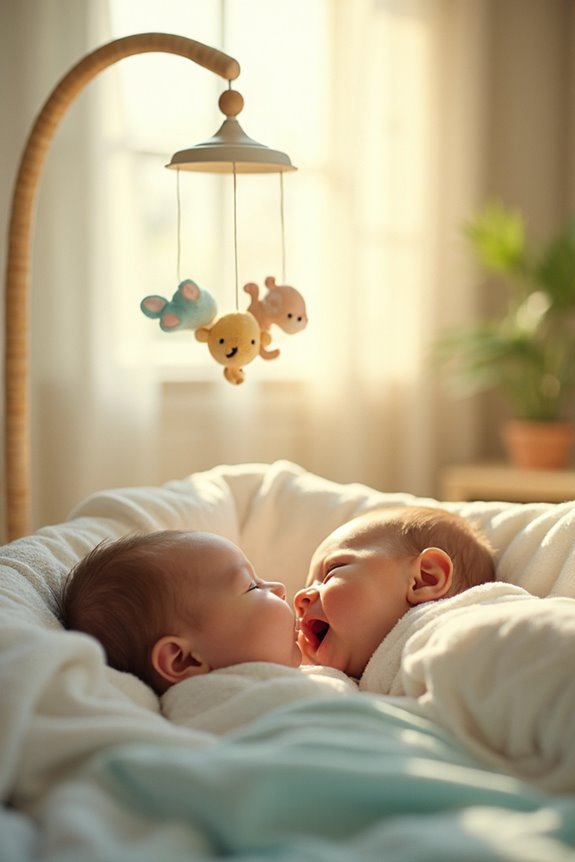
As we explore the fascinating world of our baby’s potential eye color, it’s important to understand how genetics plays a vital role in this aspect of their appearance. Eye color inheritance involves multiple genes—over 50, to be exact—that influence melanin production in the iris.
- Brown Eyes: Dominant over blue and green.
- Green Eyes: Recessive to brown but dominant to blue.
- Blue Eyes: Recessive to both brown and green.
Melanin types, like eumelanin and pheomelanin, determine the intensity and shade of our little one’s eyes. Interestingly, even if we both have blue eyes, our child could surprise us with brown—thanks to the complexity of genetic expression. Isn’t that remarkable?
Understanding Hair Color and Texture
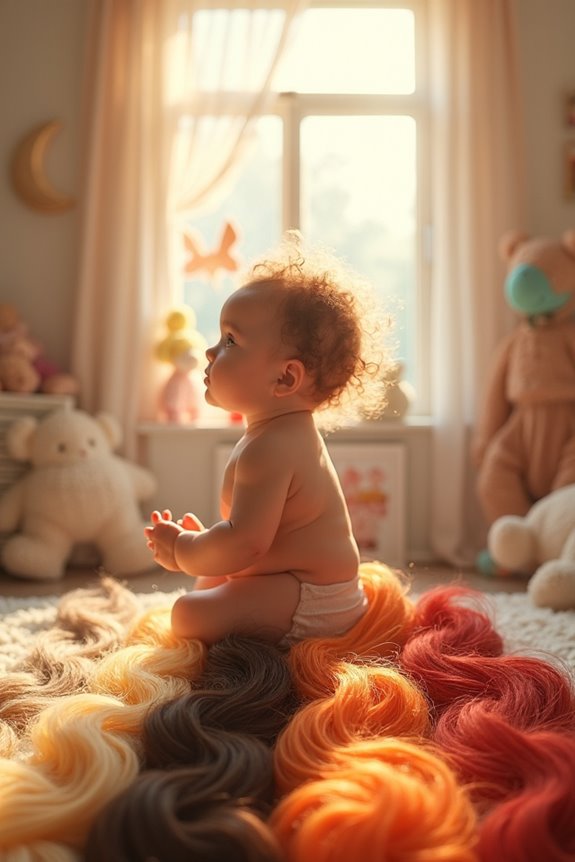
Have you ever wondered how our baby’s hair color and texture will turn out? Understanding these traits involves exploring genetic inheritance and melanin production. Here’s what we need to know:
- Hair Color: It’s determined by multiple genes. Darker colors are often dominant, while lighter shades can be recessive. For instance, if both parents are brunettes with a blonde allele, there’s a 25% chance our child could have blonde hair.
- Texture Variability: Hair texture depends on the shape of hair follicles. This means our baby could have straight, wavy, or curly hair, and even siblings might differ significantly in texture.
Though genetic predictors can guide us, the reality can be wonderfully unpredictable, influenced by both genes and the environment.
Skin Tone and Complexion Variability
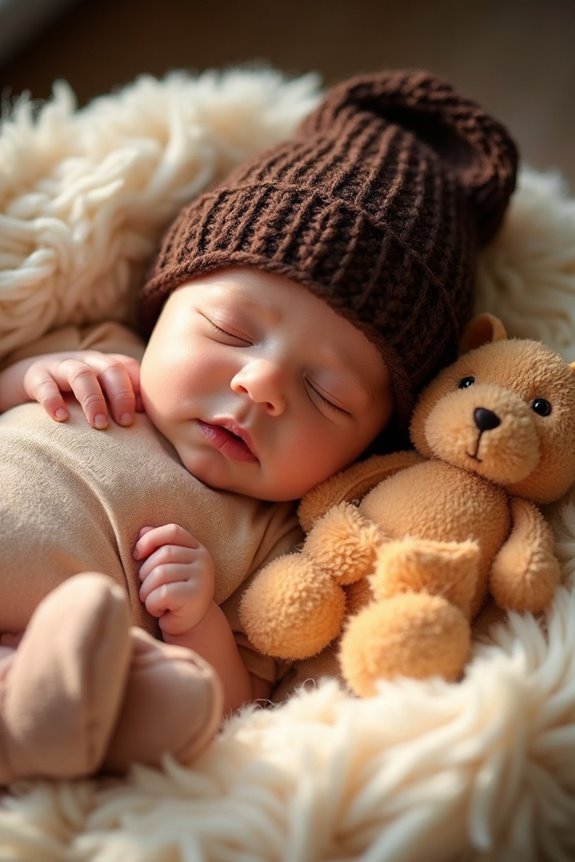
Understanding the potential range of skin tones and complexions our baby might inherit can be both fascinating and complex. As we explore this topic, we’ll discover how skin tone trends and complexion diversity reflect genetic heritage and environmental influences.
- Genetic Influence: Multiple genes determine skin color, primarily through melanin production.
- Variability: Newborns often have lighter skin that may darken over time, influenced by genetics and sun exposure.
- Family Insights: Looking at our family’s skin tones, especially grandparents’, can give us clues about our baby’s potential complexion.
Ultimately, while we can predict possible skin tones, the beauty lies in the diversity of what our little one may inherit. All skin tones hold their unique charm and contribute to our rich tapestry of life.
The Role of Genetics in Height Prediction

When we think about our baby’s future, height is another intriguing aspect that genetics largely shapes. Height genetics plays a significant role, with about 80% of a person’s height determined by inherited DNA.
- Over 700 gene variants influence this trait, many clustered in regions linked to skeletal growth.
- Interestingly, while over 12,000 variants have been identified, they only explain a portion of height variation.
You might wonder how these gene variants interact with factors like nutrition and health, which do matter but to a lesser extent.
Genetic Influences on Personality Traits
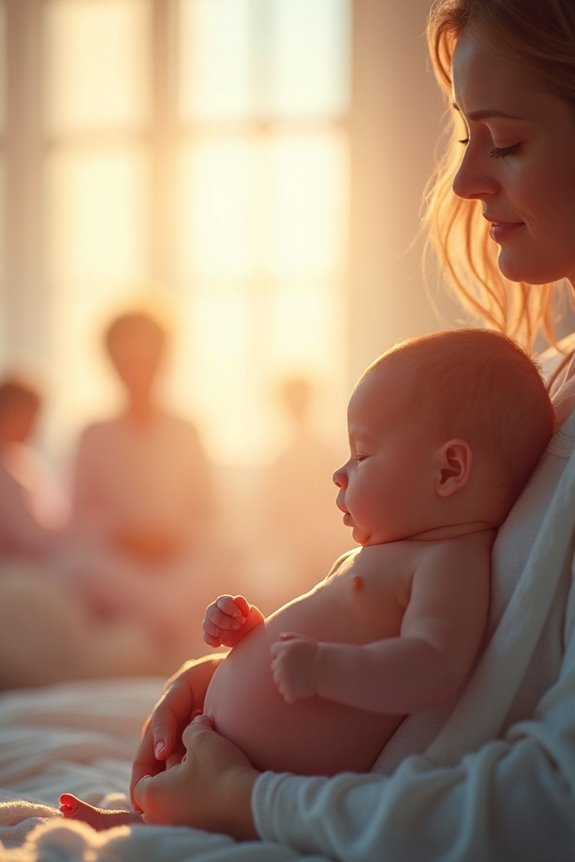
While we often think of physical traits like height or eye color when considering how our baby will look, their personality is also significantly influenced by genetics. Research shows that genetic inheritance plays a crucial role in personality development, with traits like neuroticism and extraversion having a genetic basis.
- Genetic Predispositions: Specific genes, such as those related to serotonin, can influence traits like anxiety.
- Environmental Interactions: However, it’s essential to remember that our baby’s environment will also shape these traits, interacting with their genetic predispositions.
Through these complex interactions, our little one may inherit tendencies for certain personality traits that we can nurture, helping them grow into the unique individual they’re meant to be.
The Impact of Environmental Factors
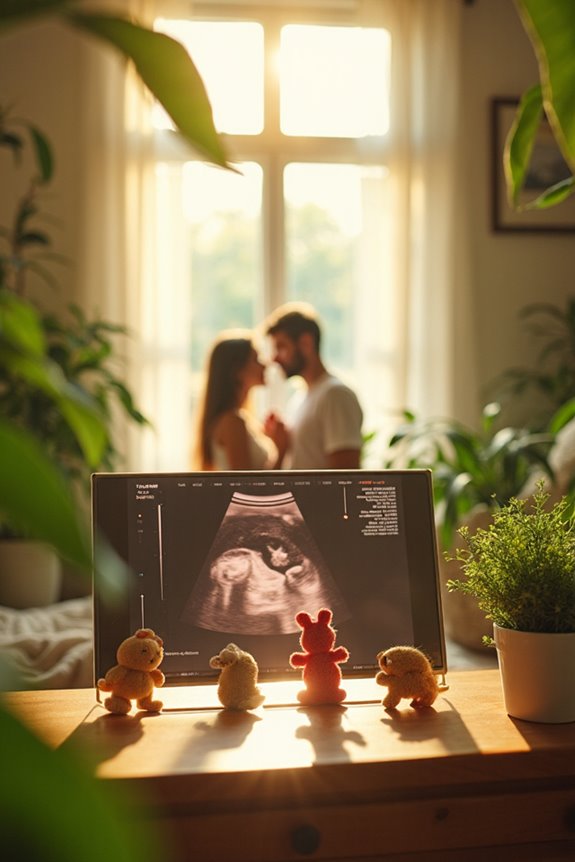
As we consider how environmental factors can shape our baby’s development, it’s important to recognize that these influences begin long before birth. We need to pay attention to several key aspects:
- Environmental Nutrition: A well-balanced diet rich in vitamins, especially folic acid, can reduce risks of conditions like autism spectrum disorder (ASD) and childhood leukemia.
- Chemical Exposure: Avoiding harmful chemicals, such as pesticides, is vital for prenatal health.
- Air Quality: Good air quality matters; polluted air can increase ASD risks.
- Climate Impact: Weather patterns affect food and water availability, influencing nutrition.
Family History and Predictive Clues

Understanding our family’s genetic background can give us valuable insights into what traits our baby might inherit. By exploring our family traits and ancestral backgrounds, we can start to predict aspects like hair color, eye color, and skin tone. For instance:
- If both parents have brown hair, there’s a good chance their child will too.
- Eye color can be trickier, as recessive genes might lead to surprises, even with dark-eyed parents.
- Skin tone usually falls between parents’ tones but can be influenced by diverse ancestry.
As we share stories about our families, we can identify patterns and clues that may hint at our baby’s unique look. This genetic tapestry can be both fascinating and comforting as we anticipate our little one’s arrival.
The Complexity of Genetic Interactions
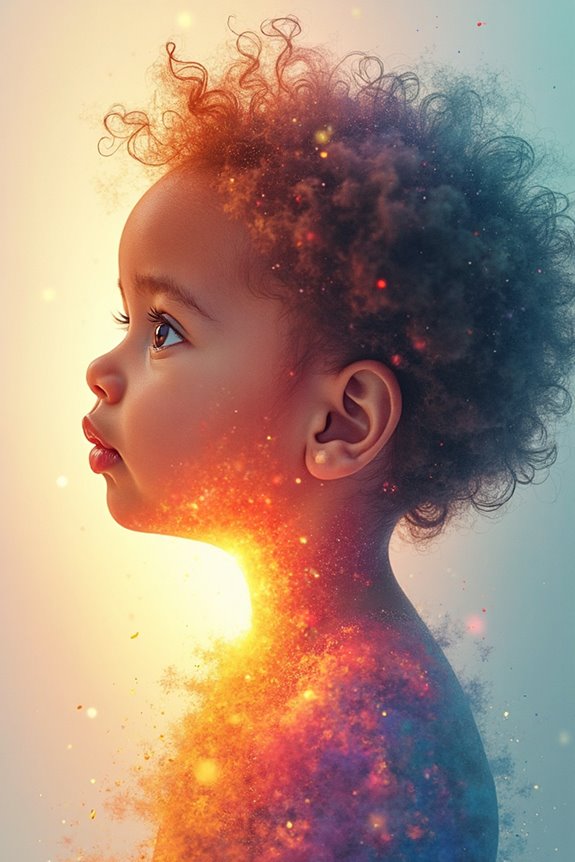
Genetic interactions can be surprisingly intricate, making it challenging to predict what our baby might look like. When we think about gene expression, it’s essential to remember that it’s influenced by many factors, including modifier genes and epistatic interactions. Our child’s appearance may arise from polygenic traits, where multiple allelic combinations contribute to phenotypic variance.
To grasp this complexity, we can consider:
- Trait Heritability: Not all traits are equally inherited; some vary greatly.
- Genetic Mapping: Techniques like QTL mapping help us understand these traits better.
With so many possibilities, predicting our little one’s features isn’t straightforward. But understanding these genetic interactions helps us appreciate the beauty of our child’s unique genetic makeup, even if it remains a bit of a mystery.
Frequently Asked Questions
Can I Influence My Baby’s Physical Appearance During Pregnancy?
We can’t directly influence our baby’s physical appearance through diet or environmental factors during pregnancy. While a healthy lifestyle supports development, genetics ultimately dictates those unique traits that make our little one special.
Are There Non-Genetic Factors Affecting My Baby’s Appearance?
Absolutely, non-genetic factors like environmental influences and prenatal nutrition play a vital role in shaping our baby’s appearance. By focusing on a healthy lifestyle, we can positively impact their growth and development together.
How Do Mixed-Race Parents’ Genes Combine for Appearance?
Like a painter blending unique hues, our genes combine to create a beautiful tapestry of phenotypic variation. Through gene expression, mixed-race heritage can yield stunning, unexpected features that reflect our diverse backgrounds and shared love.
Will My Baby’s Appearance Change as They Grow Older?
Absolutely, our baby’s growth will bring changing features over time. As they develop, we’ll witness their unique traits emerge—each smile and milestone reflecting their journey, reminding us how beautifully they transform and grow.
Can Prenatal Vitamins Affect My Baby’s Looks?
We often wonder if prenatal vitamins can influence our baby’s looks. While nutrient impact supports health and development, vitamin effects on appearance aren’t direct. Instead, genetics primarily shapes those unique features we anticipate.



